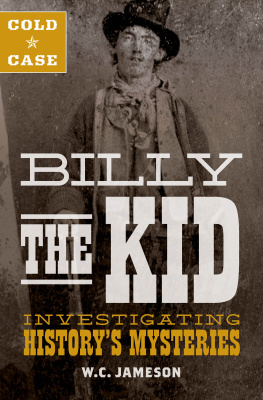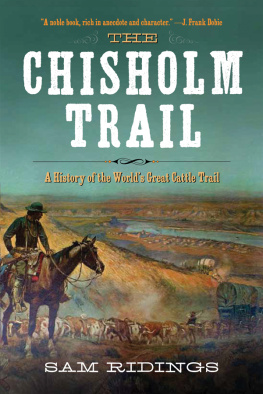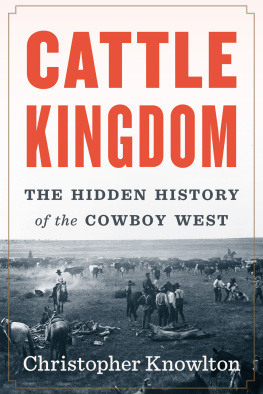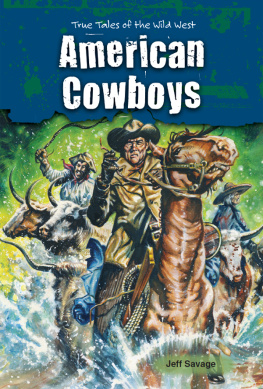Acknowledgments
I first researched and wrote about John Chisum for my book, Historic Ranches of the Old West, which was published in 1997. I visited the South Spring Ranch site near Roswell, thanks to the assistance of Morgan and Joyce Nelson, whose home was on property formerly owned by Pitser Chisum, younger brother of John. I was captivated by John Chisum, and I wrote about the cattle king in later books and articles.
I knew that the most meticulous research about Chisum had been accomplished by Harwood P. Hinton, who had accumulated information on the cattle king for half a century. As program chair for a meeting of the East Texas Historical Association in Paris, Chisums home as a youngster and his burial site, I invited Dr. Hinton to provide a keynote address. I was highly impressed by the depth of his knowledge about Chisum. After his death in 2016, his papers were donated to the Southwest Collection at Texas Tech University. I contacted an old friend, Tai Kreidler, Librarian of the Southwest Collection and Executive Director of the West Texas Historical Association. Tai informed me that the Hinton papers had not yet been cataloged, but he encouraged me to contact Monte Monroe, Archivist of the Southwest Collection. Monte generously welcomed me to Lubbock and permitted me to examine the eighteen boxes containing the Hinton materials. I am deeply grateful to Monte and Tai.
During previous projects, I had researched at the Aikin Regional Archives at Paris Junior College, and I was ably assisted on each occasion by Daisy Harvill, Director of the Archives. I drove to Paris and visited Daisy, and she rapidly produced an array of expertly arranged files, inviting me to indicate which documents I wanted to be copied. Within a week I received a large packet from the Aikin Archives, and once more Ive become indebted to Daisy Harvill. Nearby, at Texas A&M University in Commerce, I visited the archive section of the Gee Library, where I was skillfully assisted by Archivist Michael Barera. On short notice, Michael located key sources for me, and Im grateful for his genial professionalism.
My research also was richly rewarded by the trip to the Haley Memorial Library and Museum in Midland, Texas. Years earlier I had enjoyed a most fruitful trip for another biographical project, so I sent a message to the director of the Haley Library, J.P. Pat McDaniel. On the day I arrived at the Haley Library, Archivist Cathy Smith was out of town, but director McDaniel took time from his busy schedule to collect and place in front of me a wealth of materials. I worked for four hours examining these materials and indicating copies and photos I needed. A few days later I received a call from Archivist Cathy Smith, discussing my visit and making sure she understood my order. Over the next few days we exchanged several calls, and a few days later I received a bulging packet with document copies and images. I made a final call to Cathy to thank her for her efforts on my behalf.
In Santa Fe at the Fray Angelica Chavez History Library, I met Senior Cataloguer Patricia Hewitt. Our appointment was prearranged, and she had books and document files already laid out for me. We had only two hours before Patricia had to attend a meeting, so she manned the copier while I rapidly assessed and indicated which items I needed. Thanks to her energetic assistance, I was able to finish my work within the allotted time.
When I commenced this project I sought out a visit with Bill Neal at his Abilene home. Bill was raised on a cattle ranch near Quanah, and as a young man, he cowboyed out of state. Today he owns a ranch near his old homeplace. He later became an attorney for forty years. Bill always was interested in the flamboyant history of frontier lawyers, and after he retired from his practice, he penned a series of excellent non-fiction books. Because of his background as a cowboy and rancher, I wanted to explore his impression of John Chisum. I asked a number of questions, and Bill provided me with thought-provoking insights. I am indebted to Bill O. Neal, who calls me Apostrophe, while I address him as Period. Many thanks, Period.
I sat beside Judge Tom Crum at a banquet of the East Texas Historical Association in Galveston. When I mentioned that I was working on a biography of John Chisum, he informed me that his grandmother had married into the Waide family. James Waide eventually purchased Chisums ranch house near Bolivar. During Tom Crums youth, his grandmothers house was near Chisums former home, which belonged to another Waide relative. Tom described the Chisum home in detail to me and responded informatively to a bevy of questions I had about the house.
Two of my granddaughters, Chloe and Jessie Martinez, offered welcome assistance. Jessie, who studies art, created a drawing at my request of a longhorn with Jinglebob earmarks, while Chloe took a photo for me of the grave of John B. Denton. I appreciate their help. I received a book and other materials from James B. Hays of Early, Texas. Im indebted for his generosity to a stranger.
At Panola College, Librarian Sherri Baker obtained several obscure books on interlibrary loan. I have benefited from her detective work on numerous projects, and Sherri always locates books for me with enthusiasm and skill. Another member of the library staff is Shay Joines, a young woman who cheerfully agreed to produce a manuscript for me and who adeptly solved every technological problem we encountered. Shays efforts on this book were invaluable.
Chapter One
Introduction to a Cattle King
He had the knack of taking advantage of any opportunity coming his way.
Lily Klasner
H is name was John Simpson Chisum. But when he was a boy he was called Cow John, because of his affinity for the cattle on his grandfathers Tennessee plantation. After becoming an open range rancher, Chisum was plagued by rustlers, and he developed a distinctive and unmistakably recognizable earmark known as Jinglebob. Chisum soon was being called Jinglebob John and Jinglebob Chisum. As his herds grew to vast numbers, he became known as the Jinglebob King. A genial and prominent man, Chisum often was affectionately called Uncle John, as well as Old Chisum although probably not to his face. With his great New Mexico ranch stretching about 200 miles along the Pecos River, and with his cattle holdings numbering 60,000 to 80,000 head, Chisum became widely known as the Cattle King of the Pecos, the Stock King of New Mexico, the Cattle King of the West, and most regal of all, the Cattle King of America.











